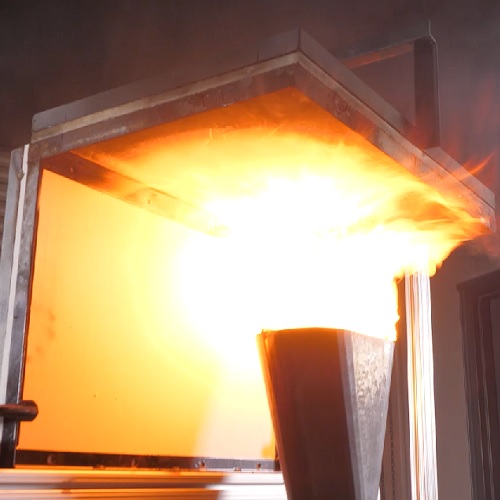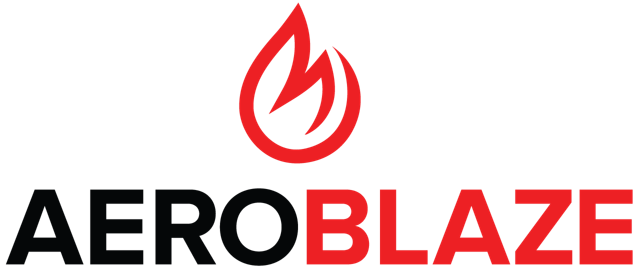Oil Burn for Cargo Liner
Oil Burn for Cargo Liner Test (for aviation)
The Oil Burn for Cargo Liner test is used to determine the flame penetration resistance of cargo compartment lining materials when exposed to a high-intensity open flame.
Test Methods

Test Summary
A sample set consisting of a ceiling and sidewall panel is placed on the test fixture. The ceiling panel is exposed to a high intensity open flame for five minutes. During the test, the temperature above the ceiling panel is recorded and the sample is monitored for flame penetration. The pass/fail criteria is based on flame penetration and the maximum temperature above the ceiling panel.
Test Sample Requirements
Test samples must meet the following requirements:
Regulatory Requirements
This test is typically used to show compliance with the following U.S. Federal Regulations:
Note 1: In the aviation industry, 14 CFR may also be referred to as "FAR" (Federal Aviation Regulations). You may see the requirements listed as FAR 25.855, etc.
Note 2: The European Union Aviation Safety Agency (EASA) uses similar Certification Specifications (CS) which correspond to those in the CFR. For example, the EASA regulations are listed as CS 25.855, etc. These regulations may also be referred to as "JAR" (Joint Aviation Requirements) and listed as JAR 25.855, etc.
Products Requiring This Test
Cargo ceiling panels, wall panels, and liners of transport category aircraft may require the Oil Burn for Cargo Liner Test when they are located in certain types of cargo compartments.
History of the Oil Burn for Cargo Liner Test
During the early post-World War II period, it was noted that adequate fire protection for cargo or baggage compartments included the factors of timely detection and prompt control of the fire when detected. Because the requirements for detection and extinguishment varied depending on the type and location of the compartment, a classification system was established. Three classes were initially established and defined as follows:
Class A — Compartments in which the presence of a fire would be easily discovered by a crewmember while at his station; all parts of which are easily accessible in flight.
Class B — Compartments with sufficient access in flight to enable a crewmember to effectively reach any part of the compartment with the contents of a hand fire extinguisher and that incorporates a separate, approved smoke or fire detection system to give warning at the pilot or flight engineer station.
Class C — As defined at the time of initial classification, any compartment that did not fall into either Class A or B was a Class C compartment. Class C compartments differ from Class B compartments primarily in that built-in extinguishment systems are provided for control of fires in lieu of crewmember accessibility.
Later, two additional classes were established and defined as follows:
Class D — Compartments in which a fire would be completely contained without endangering the safety of the airplane or the occupants.
Class E — The main cargo compartment of an airplane used only for the carriage of cargo.
At the time, cargo liners were only subjected to vertical and 45-degree bunsen burner tests. In the late 1970s to early 1980s the Federal Aviation Administration (FAA) conducted a series of tests at its Technical Center to investigate the capability of three typical liner materials to resist flame penetration under conditions representative of actual cargo or baggage compartment fires. The tests were conducted using simulated Class C and D compartments. In conjunction with these tests, the FAA developed a method of testing liner materials utilizing a 2 gallons-per-hour kerosene burner, similar to that used in the Powerplant Fire Penetration Test. It was found that a fire could rapidly bum through Nomex or Kevlar under representative conditions. This, in turn, could result in a fire of increased intensity. It was therefore concluded that improved standards were warranted for the sidewall and ceiling liner panels of all classes of cargo or baggage compartments that depend on liners for fire control.
In 1986, The FAA issued a final rule amending 14 CFR 25.855 to add a new requirement for fire penetration resistance of cargo compartment liners. This new rule required all ceiling and sidewall liner panels in Class C and D compartments to meet the oil burn for cargo liner requirements of the newly created 14 CFR 25, Appendix F, Part III.
Individual manufacturers and organizations also established their own internal versions of the Heat Release Rate Test, such as Airbus (ABD0031/AITM 2.0010), Boeing (BSS 7323), and McDonnell Douglas (DMS 2273).
In order to facilitate improvements to the test standard without constantly changing the CFR, the FAA published Report DOT/FAA/CT-99/15 "Aircraft Materials Fire Test Handbook" in 1990. The tests in this handbook are considered an acceptable equivalent to those in the CFR. The handbook was updated in 2000 to DOT/FAA/AR-00/12, with the Oil Burn for Cargo Liner test located in Chapter 8 of the handbook.
Sources: Federal Register Vol. 49, No.154 / Federal Register Vol. 51 No. 95
Additional Resources
| Resource | Description |
|---|---|
| 14 CFR 25.855 |
Cargo or Baggage Compartments (Transport Category Airplanes) U.S. Regulations for FAR 25.855 at Amendment 25-142. |
| 14 CFR 25, Appendix F |
Appendix F to Part 25 (Transport Category Airplanes) U.S. Regulations, Criteria and Test Procedures. |
|
FAA Fire Test Handbook, Chapter 8 |
FAA Aircraft Materials Fire Test Handbook (DOT/FAA/AR-00/12); Chapter 8; Oil Burner Test for Cargo Liners. This handbook provides an acceptable means of compliance with the relevant regulations. This is the preferred test method to find compliance with the listed regulations. |
|
FAA Fire Test Handbook, Chapter 15 |
FAA Aircraft Materials Fire Test Handbook (DOT/FAA/AR-00/12); Chapter 15; Two Gallon per Hour Oil Burner Certification Testing for Repaired Cargo Compartment LIners. This handbook provides an acceptable means of compliance with the relevant regulations. This is the preferred test method to find compliance with the listed regulations. |
Ask the Experts

Stuck? Our experts will help you determine the best solution for your needs.
Contact Us